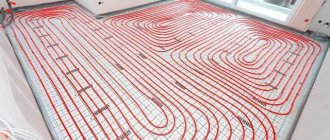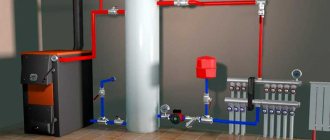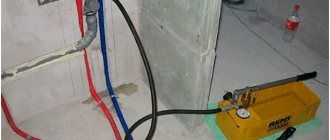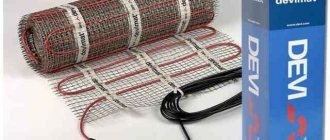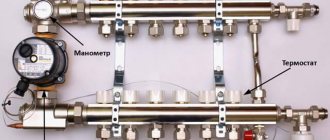Heating a home using liquid coolant is the most popular. The reliability of heating systems consisting of sets of equipment and pipelines depends on the coolant and its characteristics. The task of the coolant is to transfer the maximum amount of thermal energy at minimal cost.
Replacing one type of coolant with another is done to increase the efficiency of the heating system. But before you pump or replace new coolant into the system, you need to select the coolant itself.
Types of thermal media
The cheapest coolant is water. But the use of water is not always justified. Water should be used in heating systems that are not subject to corrosion. The use of water as a heat carrier has certain reservations. Such a coolant must be processed by distillation, this will protect the heating system from the formation of scale in it. The use of water that freezes at zero temperatures can destroy pipes in the event of an emergency shutdown.
Injecting special “anti-freeze” agents as a coolant allows you to ensure high-quality operation of the home heating system. The market for manufacturers of antifreeze for heating offers various types of thermal media, made on different bases and having certain characteristics, on which their final price depends.
Basic requirements for a coolant:
- The degree of viscosity of the thermal fluid with temperature changes;
- Inertness of antifreeze in relation to other materials;
- The thermal fluid must not be corrosive and be safe for residents in terms of toxicity and ignition;
- Thermal conductivity of the material;
- The price of the thermal fluid must correspond to its payback period.
We expel the air
It is a well-known fact that air in heating systems accumulates at the highest points of the system. For underfloor heating systems, this is a collector comb, where air discharge devices are installed (Mayevsky valves, automatic air vents or conventional ball valves).
Mayevsky tap installed on the underfloor heating manifold.
To remove air from the underfloor heating system, you must perform the following steps in a certain sequence:
- Shut off all horizontal branches on the collector.
- Remove air from the circulation pump housing.
- Open the Mayevsky valve or ball valve on the comb (in the absence of automatic devices).
- Open the first water circuit, start the pump, setting the minimum capacity on the regulator.
- After waiting for water to appear from the air outlet of the pumped branch, turn off the tap and turn off the pump.
- Repeat the operation several times at intervals of 5 - 6 minutes until the air is completely removed.
- Similarly, perform all operations with the remaining contours.
- Then, switching the pump to maximum performance, pump the entire system as a whole, periodically bleeding air.
- Considering the likelihood of new plugs forming during subsequent warming up of the system, it is necessary to bleed the air again.
Important! Putting the system into operation is possible only after all these measures have been taken and it has been fully checked for leaks. To work with Mayevsky taps, you must have a special key or slotted screwdriver
It would be useful to prepare a special container for drained water.
When using automatic gas vents or separators as air removal equipment, no additional means are required. It must be remembered that as the complexity and quantity of equipment used increases, the cost increases and the reliability of the system as a whole decreases.
Types of fan coil units, their differences and features
The lower the degree of automation of the process, the higher the performance of heated floors. Adjustable manifold valves with a mechanical drive, Mayevsky taps are easy to service or replace with your own hands.
Repair of more complex equipment with servo drives and automation units requires the participation of specialists. In addition, automatic air vents, while effectively removing air pockets, do not always allow immediate detection of system leaks.
Popular antifreezes for heating
Ethylene glycol-based antifreezes are divided into two categories depending on their freezing point: - 30 °C and - 65 °C. This type is cheap and cold resistant.
Antifreeze based on ethylene glycol has a significant drawback - high toxicity, which limits the conditions for its use. Ethylene glycol, which is colored red by manufacturers to warn of danger, is not used in open heating systems.
Propylene glycol, colored green by manufacturers, is safe to use. The coolant has a freezing point of 35 °C and can be used in systems with an open expansion tank.
Antifreeze made from glycerin is safe to use and has a freezing point of 30 °C. In comparison with ethylene glycol and propylene glycol, it has a number of advantages and can successfully replace them:
- protects corrosion nodes and does not damage parts and elements;
- compared to coolants based on ethylene glycol and propylene glycol, with a service life of no more than 5 years, glycerin-based antifreeze has a longer service life - up to 8 years;
- the liquid is sold in diluted form, ready for use;
Fact! Glycerin-based antifreeze can be used in heating systems as a replacement for another type of coolant, without flushing the pipes.
Crystallization temperature of ethylene glycol-based antifreeze
Ethylene glycol is not ideal as a coolant due to all its risks.
- Highly corrosive (much higher than water). Suitable inhibitors are used to reduce corrosiveness.
- It has the ability to foam, which is again compensated for by appropriate additives.
- More liquid than water causes leakage problems. Due to the toxicity of ethylene glycol, this can be a problem. It is necessary to work with liquids, paying attention to protective gloves and goggles. In addition, all objects and substances that absorbed the solution are toxic. They are subject to replacement and destruction.
- Ethylene glycol does not react well to overheating. When the temperature rises to 70°C, active precipitation occurs, which significantly reduces the heat transfer of the thermal device. And this again leads to overheating. After overheating, the properties of the liquid change dramatically, which makes the antifreeze impossible to continue working. According to this criterion, it should be noted that in systems with solid fuel boilers, ethylene glycol-based antifreeze cannot be used: without 95 ° C more regularly than without, and without automation to control the position of the heat exchanger, it inevitably overheats.
Filling the heating system with antifreeze
Before pouring antifreeze into the heating system with your own hands, you need to correctly calculate how much liquid will be needed and how much to buy. To carry out calculations, it is necessary to calculate the volume of the entire heating system.
There are special tables that allow you to accurately calculate how much antifreeze needs to be poured before initial use or replace one antifreeze liquid with another, based on calculations made per linear meter of pipe. Using such calculations and knowing the diameter of the pipes, you can calculate how much coolant is required per 10 m of the system. It remains to be clarified how much antifreeze needs to be added to fill the battery section. By adding up all the data, you can get the total volume of antifreeze required to fill the system. There is no single formula - filling depends on the diameter of the pipes and the volume of the radiators.
In most cases, the container in which the thermal fluid is sold contains information about the antifreeze sold and its density. Such data allows you to calculate how much water needs to be added to the liquid, which will serve as a heat carrier.
To refill the antifreeze with your own hands, you need to have a pump or special equipment that allows you to carry out the procedures of purging and flushing from used residues. For filling work you will need: a screwdriver, pliers, an adjustable wrench, hoses for pumping coolant, fixing clamps and sealing tape.
How to add antifreeze to your home heating system
A country house or dacha, where the owners come to relax on weekends, is heated periodically during the winter. Therefore, the question of whether to pour antifreeze or water into the heating system of such a home is not subject to discussion. To prevent defrosting of equipment and pipes, they must be filled only with non-freezing liquid. Since the topic is of interest to many homeowners, in this material we will tell you how to choose antifreeze for heating and correctly pour it into the system.
Selecting an antifreeze fluid
For filling into heating systems of private houses, the market offers 2 types of non-freezing coolants made on the basis of:
- ethylene glycol;
- propylene glycol.
The first type of antifreeze can be described in literally two words - cheap and toxic, while propylene glycol is safe but expensive. For obvious reasons, most sellers actively offer the second type of coolant, focusing on its safety for human health. At the same time, a theory is being developed that a small amount of coolant can get into drinking water through the hot water supply system or poison almost every living thing in the house if it leaks from the connections of the heating system.
In fact, high-quality and correctly installed heating will not give the slightest chance for antifreeze to get into the water, and leaks are so insignificant that they do not pose a danger. Another thing is the loss of the warranty on the boiler, because most manufacturers do not allow their heat generators to operate with anti-freeze. But this applies to any glycols, except those that the boiler manufacturer itself allows for use.
The conclusion is simple: when you are confident in the quality of the assembly of your heating system and are short on funds, then feel free to fill in ethylene glycol, carefully monitoring the process and strictly following the instructions. If you want to be on the safe side, backed by opportunities, then pay the required price for propylene glycol, fill it up and sleep peacefully.
In most cases, antifreeze for heating systems is sold in the form of a concentrate, which must be diluted before being poured into the heating network. It is recommended to dilute it strictly in accordance with the instructions; there is no need to make the solution too strong. This can cause deposits to appear in different places and on the heat exchanger. Antifreeze must be changed no later than after 5 years of operation.
How to pour antifreeze into an open system
This is exactly the case when you should buy safe propylene glycol. It's all about the open expansion tank communicating with the atmosphere. Since it is located within the house (usually in the attic), small amounts of fumes can enter the living spaces. In general, pouring antifreeze into an open system is not advisable. It is better to convert it into a closed one, from where it will not evaporate.
The diluted concentrate is poured through an expansion tank or make-up valve using a pump. In this case, all Mayevsky air valves installed on radiators must be open. As the tank is filled, the taps are closed, after which the coolant level is brought to approximately 1/3 of the expansion tank.
Advice. Before you pump antifreeze into the heating system of your home with your own hands, you need to make sure that all shut-off and control valves are open.
After starting and warming up the boiler, you need to bleed the air through the batteries again. If the level of heated coolant in the expansion tank has dropped, then add antifreeze to about half.
Filling a closed heating system
Here, it is most convenient to carry out the filling process using a pump connected to the system’s replenishment fitting. If there is no pump, then you will have the grueling job of pouring antifreeze through the highest point by unscrewing the automatic air vent. It is also advisable that an assistant participate in the operation. Its job is to release air from the batteries while you are pumping antifreeze into the boiler room. Before starting work, make sure that:
- all shut-off valves are open;
- the boiler shut-off valves are closed;
- the concentrate is diluted according to the instructions;
- Mayevsky relief valves are closed;
- the valve shutting off the membrane expansion tank is open.
Features of antifreeze
Water is considered the cheapest and most accessible coolant for heating devices. But at low temperatures, a change in its physical properties occurs, which can lead to the failure of the entire floor heating system. To avoid negative consequences, a special solution, antifreeze, is used to fill the water circuits.
Such a liquid reagent is a substance that does not change its state at sufficiently low temperatures. The high anti-corrosion properties of antifreeze allow it to be used for pipelines made of various metals. At the same time, the finished coolant does not contribute to the deposition of various sediments and scale inside the water circuit.
Thanks to these properties, the use of antifreeze allows you to turn off the heating system in severe frosts without first draining the coolant. The reagent is especially popular in country houses, where owners do not have the opportunity to constantly monitor the quality of the operating process of heating equipment.
The types of antifreeze produced have different temperature indicators. On packaging with a viscous liquid, manufacturers indicate at what maximum values the coolant can be used.
Basically, the finished solution is designed for temperatures from -30 to -65 degrees. But when these limits are exceeded, it does not harden, as usually happens with water, but becomes gel-like. At the same time, the reagent retains all its original characteristics, and therefore is not capable of harming the floor heating system.
How to choose antifreeze for heating
On the market you can find a fairly large assortment of antifreezes for heating. And before you make a choice towards one product or another, you need to decide on the temperature threshold for antifreeze. There are two types of antifreeze, according to temperature characteristics:
- With a temperature threshold of minus 65 degrees, calculated for the conditions of the far north;
- And with a threshold of minus 30 degrees, designed for a more benign climate, in the middle zone.
There are also antifreezes with an intermediate temperature threshold. An example is the famous Galan Potok -40C 50l, with a freezing point of minus 40 and a capacity of 50 liters. Based on the content of the main antifreeze substance, antifreezes are divided into the following compositions:
- Aqueous salt solutions (suitable for PVC pipelines or galvanized metal pipes, in combination with aluminum radiators).
- Alcohol-containing compounds (suitable for all types of pipes and heating elements).
- Oil antifreeze (suitable for all types of pipes).
Interesting fact!
Craftsmen and self-taught inventors, back in Soviet times, adapted transformer oil(!) as antifreeze for heating houses and country cottages.
Determine the required antifreeze consumption
How to calculate the required antifreeze consumption yourself, so that later there is no excess left, or vice versa, so as not to buy less than required? You can calculate the required amount of antifreeze with only a superficial knowledge of mathematics. To do this, you need to remember a few nuances:
- 1m3=1000 liters;
- The area of a circle is determined by the formula , where , a – radius (given in meters);
- The volume of pipelines (displacement) is determined by the formula , where is the number of pipes in meters;
- One cast iron section of the radiator contains 1.45 liters of water.
- The volume of registers and convectors is calculated using the same formula as pipelines;
- The volume of the heating boiler is indicated in the passport; if there is no passport or the boiler is homemade, then we calculate the volume of the heating boiler as well as the pipelines (often home-made and factory-made heating boilers are made from large-diameter pipes);
- Ultimately, the coefficient should be taken into account - 1.05 (plus 5% of the total requirement)
Example:
- We have a heating boiler with a capacity of 80 liters, a pipeline with a total length of 56 meters, a diameter of 20 mm and cast iron radiators in the amount of 15 sections.
The calculation will look like this:
- Pipelines - 3.14 (value) X 0.01 (pipe radius in meters) X 56 meters = 0.01758 m3 or 17.58 liters;
- Cast iron radiators - 15 sections x 1.45 liters = 21.75 liters;
- Heating boiler – 80 liters;
- Total – 17.58+21.75+80= 119.33 liters
- Total, taking into account the increasing factor (necessary for an emergency and creating a small reserve) - 119.33X1.05 = 125.3 liters.
Articles on the topic
The main source of heat transfer in a hydronic floor heating system is the coolant. In most cases, water is used as the liquid circulating in the network through pipes. But many experts recommend using special antifreeze for heated floors for these purposes. In this case, the main thing is to choose the right reagent that will improve the quality of heating and will not harm the equipment.
Content
Types of antifreeze and their properties
There are three main types of ready-made coolants on the modern market, which are successfully used in underfloor heating water circuits. Each individual group of antifreeze has its own composition, advantages and features of use.
Glycerin based solution
The coolant, the main component of which is glycerin, is successfully used for heating systems in houses of various types. Its main advantage is the absence of harmful components, which ensures its safe use in residential areas.
Glycerin-based antifreeze is non-flammable and has a relatively high level of heat transfer. The solution can withstand a maximum temperature of -30 degrees, which allows, if necessary, to turn off the heated floor system in severe frosts in winter.
The reagent consists of glycerin water and various additives that help improve its technical characteristics. For a metal pipeline, the mandatory presence of an anti-corrosion additive is required, since the use of a pure glycerin solution can lead to destruction of the system structure.
Antifreeze for heated floors based on glycerin
The main advantages of glycerin-based coolant include:
- safety and environmental friendliness of use;
- the presence of additives that prevent corrosion processes;
- Possibility of use for up to eight seasons in a row;
- fire safety;
- no negative impact on parts of the heating structure made of rubber or plastic;
- resistance to fairly low temperatures -30 degrees.
When the temperature limit is exceeded, glycerin antifreeze crystallizes. But at the same time it practically does not increase in volume. This property eliminates the possibility of pipeline rupture in the most severe frosts.
There are few disadvantages of using it:
- high viscosity of the solution, which requires the installation of high-power pumps;
- At elevated temperatures, the glycerin reagent can be converted into a substance with a pungent odor - acrolein.
When used in a floor heating system, parts made of plastic or non-polar rubber must be sufficiently durable and of high quality.
Ethylene glycol aqueous solution
Antifreeze with the lowest cost and fairly high efficiency. But its use is somewhat limited due to high toxicity. In this case, the freezing temperature of the viscous solution reaches -60 degrees. This characteristic allows the reagent to be used in the harshest winter conditions.
The coolant ethylene glycol contains special additives that prevent the rapid chemical process caused by the main substance.
The advantages of using ethylene glycol-based antifreeze include:
Classification of heating systems
To fill it out correctly, you need to know what type it is. There is a classification of systems according to the method of pipe routing: from the top, from the bottom, horizontal, vertical or combined. According to the method of connecting devices using pipes, systems are divided into: single-pipe and double-pipe.
Also, water can circulate in the system naturally or forcefully (if a pump is used). Based on the scale of operation, local and central heating systems are distinguished. As the water moves in the pipes, there are dead-end and passing pipes. All these types are used in mixed order in everyday life.
Criterias of choice
The selection of antifreeze for floor heating systems is carried out taking into account all the technical and structural features of the heating equipment. Since the main function of ready-made coolants is protection against freezing, when choosing a solution you should pay attention to the temperature limit for its use.
When using antifreeze for heated floors in residential premises, it is first necessary to consider such an indicator as complete safety of use and the absence of toxic substances in the composition.
To choose an effective coolant for a floor heating system, you should consider the following points:
- presence and composition of additives;
- the ability to combine with metals, plastic, zinc or rubber;
- temperature threshold;
- duration of use.
Additives that improve the properties of antifreeze must meet the design requirements of floor heating equipment. If a metal circuit is installed, it is recommended to pay attention to the quality of anti-corrosion additives. To protect rubber elements, special softening agents are required.
First start-up and pressure testing of the water-heated floor heating system
Upon completion of installation, before laying the screed or forming the floor covering, the functionality of the heated floor is checked in operating mode. To do this, you need to run the entire system in test mode. The purpose of such a start-up is to check the performance of all elements of the heating system. As a result of the start-up, the intensity of circulation of the coolant through the water circuit is determined, how the floor surface is heated, whether there are any defects or malfunctions in the operation of the heating equipment.
Note: after filling the system with coolant, there is no need to drain it before laying the screed. The solution is applied to the filled pipes so that the water circuit takes on its optimal working dimensions.
In practice, three methods are used to check the performance of a water floor. Let's look at what they are in more detail.
1. The assembled system is brought to the optimal temperature regime and maintained in this form for several days.
2. A system filled with cold coolant can be checked for integrity by increasing the pressure in the pipeline.
3. Preliminary pressure testing of the entire heating system with air.
Important! To test (pressure test) the water circuit with air, a compressor is used, pumping air into the pipeline at a pressure of up to 5 bar, no more. Otherwise, the integrity of the system at the connection points may be compromised.
You choose the testing method yourself. It should be remembered that when testing the water circuit using high pressure air, the absence of a tie may adversely affect the integrity of the pipeline. Usually in such cases the pipes are torn out from the mounting locations where the water circuit is secured with conventional mounting tapes and single fasteners.
To avoid such a situation, install beacons for the future screed at a certain distance (step) and secure them with a solution. With such a frame, you can safely begin purging the heating circuit.
If the pipes were laid without loops or bends, you will not face such problems. Leaks in this case usually occur at the points where the circuit is connected to the collector.
Testing the system in various modes
The system connected to a heating device or to a DHW source is brought to normal operating temperature. At this moment, the water heated floor is adjusted in different temperature conditions. We start from the minimum, from 200C. Consistently, over the course of 2-4 hours, we raise the heating temperature by 50, and this is done throughout the entire time, reaching the optimal operating temperature of 35-450C. All this time, the condition of the pipeline is being monitored. Joints and connection points are examined for leaks. After reaching the design capacity, the system is left in operating mode for a couple of days for final shrinkage. Only after no serious deficiencies have been identified can you begin pouring the screed or installing the floor structure.
When checking the heating water circuit with excess pressure, the algorithm of actions is slightly different. In a system filled with cold coolant, a pressure is created that is 1.5 to 2 times higher than the working one. By leaving the system under pressure for a day, we identify the presence of defects and malfunctions. If there are no leaks, you can begin installing the screed.
The third option, which involves dry crimping, is used extremely rarely. The compressor is connected to the manifold at the inlet and air is pumped into the system. You need to be careful with pressure parameters. It is not allowed to exceed the air pressure 2-3 times higher than the working, design pressure. This method does not always give the desired effect, especially if antifreeze is used.
Note: antifreeze has increased fluidity, so it is best to check the system for integrity by first filling it with coolant.
When using a pressure of more than 4 bar during the test run, it is necessary to keep the drain valves - air vents closed.
For metal-plastic pipelines, cold coolant is usually used during the first start-up. In this case, the pressure can be raised to 6 bar.
If we are talking about polypropylene pipes, the system must first be checked with ordinary water supplied under high pressure. Test pressure should be 2-3 times higher than normal operating pressure. If after some time the system does not leak, you can return to normal mode by reducing the pressure to 1.5 bar.
In the video you can see in detail which devices and in what order pressure testing of heating systems is carried out.
Rules for using antifreeze
The use of ready-made high-quality coolants allows you to increase the efficiency of heated floors. Regardless of the type of antifreeze for the heating system, during the operation of the solution, the following basic requirements should be adhered to:
- For metal pipes of heated floors, antifreeze is used, which contains additional anti-corrosion additives.
- Due to the high level of viscosity of the finished coolants, the installation of circulating pumps with high power is required. In this case, the pipeline must have a diameter of more than 20 millimeters.
- It is necessary to replace antifreeze on time. The period of use of the solution depends on its type. For reagents based on propylene glycol and ethylene glycol, the service life is about five years. Glycerin antifreezes have a longer service life - up to ten seasons.
- Before using ready-made coolants, check the tightness of all connections. This point is of particular importance when using ethylene glycol, since its contact with the finishing coating leads to the destruction of the material, and human inhalation of vapors can cause serious poisoning.
- Antifreeze should be used for the floor heating system after the water circuits have been completely flushed. Metal pipes should not have rust or various deposits in the form of scale inside.
Antifreeze for underfloor heating is the best way to protect the system in winter. Its use allows you to easily turn off heating equipment for a long time on the coldest days.
The effectiveness of using ready-made coolants depends on the correct selection of the composition and its compliance with the technical requirements for installing heated floors. When purchasing such a liquid, you should always pay attention to the compatibility of the product with various materials, and also take into account the characteristics of the additives included in the composition.
How to turn on a heated floor correctly
The use of an underfloor water heating system for heating residential premises requires special attention from the contractor. Knowing how to turn on a heated floor correctly, you can avoid making changes to its design after laying the screed. The wrong approach will lead to the need to dismantle the floors and additional costs. A responsible procedure is the first commissioning of such heating and the selection of a suitable thermostat.
Filling rules
Before starting a warm water floor, it should be filled. The filling method is selected depending on the type of system and coolant, which uses both water and antifreeze. In the future, the liquid will have to be poured into the heated floor annually, and each time the pipes will need to be washed before doing so. Water is poured into the system and continued to be drained until it remains clean.
The first stage of filling is common for any option. Before filling the underfloor heating system with coolant, all fittings are opened. Including shut-off valves, valves on the manifold, three-way valve on the mixing unit, air vents. The next steps depend on what kind of coolant is poured into the pipes, water or antifreeze, and the type of heating.
For a closed water system, before running the heated floor through the collector, perform the following steps:
- wait until all the air comes out of the pipes;
- turn on the circulation pump;
- keep the pumping equipment turned on for about 3 minutes until most of the air leaves the system, closing and opening the valves on each circuit in turn (if there are several of them);
- turn off the pump.
When using an open system, before starting the heated floor, perform the same steps as for closed heating. The differences lie in the absence of a pump to move the coolant and the fact that only water can be used for it. In this case, the air is removed due to the pressure in the water supply system, from which the floor is filled with liquid. First, the circuits are filled using a tap on the manifold, connecting the hose to the pipes. Then they close the valve and open it after a while, adding liquid, the pressure of which drops as air leaves the pipeline.
Before starting a heated floor when using antifreeze (the advantage of which is maintaining low temperatures), the system is filled using a special method. To fill, you will need special equipment - a crimping machine. The hose of the device is connected to the manifold and the coolant is pumped into the pipes. After filling the system with antifreeze, excess air is removed, turning on the pump.
Rules for crimping heated floors
The choice of how to start a heated floor for the first time depends on the material of the pipeline. This launch is called “pressure testing” and is a pressure test of the heating system to detect leaks. The work is carried out before pouring the screed and immediately after filling the pipes with coolant.
Different types of heated floors have their own characteristics of crimping:
- For metal-plastic pipes, cold water or antifreeze is poured into the system at a pressure of 6 bar. If the pressure does not drop within 24 hours, the test is considered successful.
- For pipelines made of cross-linked polyethylene, the pressing pressure must be no less than double the working pressure or the same 6 bar. When the pressure drops, it is raised three times every half hour. After the third time, the system is filled with liquid and left for a day - the test is considered passed if the pressure drops by no more than 1.5 Bar.



